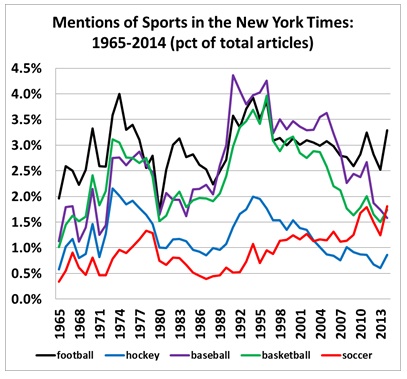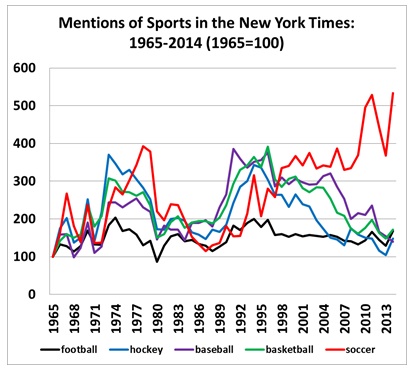12 September 2014
It is a favorite debating topic among football fans in the United States: has soccer arrived in the United States? On one level the question simply reflects the fundamental insecurities of the American soccer supporter of a certain vintage. But those insecurities are based on experience. If you grew up when I did, in the 1970s and 1980s, soccer was a third-tier sport at best. My high school did not even get a varsity team until my junior year in 1985.
On the other hand, trends do change, and it worth asking what role soccer plays in today’s US sports landscape. For me a first indication that things were really changing occurred when I moved my family to Oxford in 2007 for an academic sabbatical. The most noticeable difference was not the lack of Colorado sunshine or the wallet-exploding exchange rate, as significant as those were. Instead, it was the loss of ready access to weekend European football and Champion’s League matches, both easily found on my US TV. That was almost enough to have me pack for home.
At FiveThirtyEight Carl Bialik has been asking where soccer stands among US fans, and he has presented some interesting data. For instance, from 2009 to 2013 the US TV audience for Premier League and Champions League matches has doubled. Other data is less conclusive about any rise in US soccer.
Here I take a different look at the growth of soccer in the US by examining its presence on the pages of the New York Times over the past 50 years. The New York Times is often referred to as the “paper of record” in the United States. Whether it is or is not is probably a debate for the pub, but clearly its long history and elite standing make it an important indicator of the focus of attention, at least among a particular elite, in the United States.
The data that I present below come from a very cool online tool called “Chronicle” that allows the user to track the presence or a word or phrase on the pages of the Times since the 1860s.
I searched the NYT for the occurrence of football (meaning gridiron football, as in NFL principally), hockey, baseball, basketball and soccer. The first figure below shows the results. American football, not surprisingly, is the most mentioned sport. But a big surprise was that soccer is now in the second spot. This result is due both to the growth of soccer’s presence on the pages of the New York Times, but also the reduction in coverage of baseball and basketball. For baseball the drop in coverage is significant, from being the most covered sport from 1990—2005 to a tie for third, with basketball which has also seen a marked decline in coverage.
Article continues below
.
We can also look at the data in relative terms to better look at changes over time. The graph below shows that of the major US sports, soccer is the only sport with significantly increasing coverage in the NY Times since 1965. The others have seen some ups and downs, but nothing like the phenomenal growth of soccer, which really started taking off on the mid-1980s. (Note: The start of this trend coincides with my own high school and club soccer career. Correlation is of course not causation, though the coincidence here is striking.)
Article continues below
.
So what does this data tell us?
It provides another indication that soccer is indeed becoming more significant in the US sports landscape. The US sporting context is fairly unique worldwide because it supports simultaneously a number of major professional sports. Most countries have just one major professional sport that dominates media coverage (and not surprisingly it is usually football, see this presentation in PDF for some data). In the US, therefore, the rise of soccer does not mean that other sports necessarily must decline. And of course, the rise to second place in 2014 may just be a blip fueled by the recent World Cup.
In addition, the coverage of soccer in the US is not the same thing as the rise of the US domestic professional league, Major League Soccer. A quick look at the NY Times Chronicle tool shows that UEFA is referred to more than MLS, and FIFA dwarfs them both. In fact, FIFA is not far behind the NFL in mentions, and regrettably both are in the news for reasons beyond what happens on the field.
US men’s and women’s soccer have already established themselves on the international stage. Now it seems soccer is also reaching new heights in the crowded mix of sports most followed by American fans. The state of US soccer will always make for a fun pub debate. Thanks to the New York Times, that debate can be informed by a few more numbers.
.
Roger Pielke Jr. is a professor of environmental studies at the University of Colorado, where he also directs its Center for Science and technology Policy Research. He studies, teaches and writes about science, innovation, politics and sports. He has written for The New York Times, The Guardian, FiveThirtyEight, and The Wall Street Journal among many other places. He is thrilled to join Sportingintelligence as a regular contributor. Follow Roger on Twitter: @RogerPielkeJR and on his blog
.
More on this site mentioning sport and money
Follow SPORTINGINTELLIGENCE on Twitter












